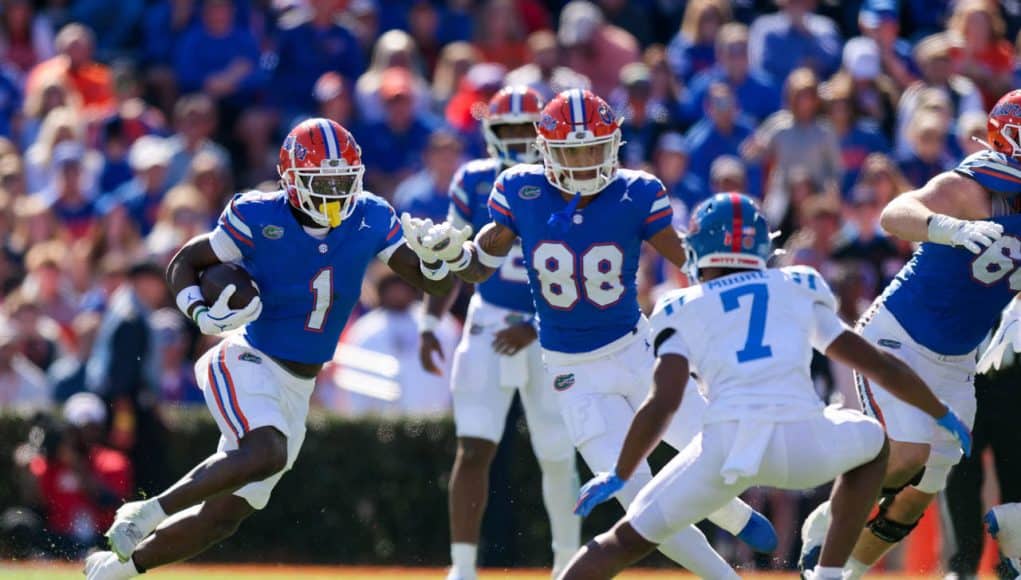Most of Gator Nation is familiar with Billy Napier’s love for two tight end sets, which he frequently utilized once again in 2024. But how does Florida perform in 12 personnel compared to 11, and should they be using one grouping more than the other? Let’s take a look.
Let’s start with 12-personnel, which consists of one running back, two tight ends, and two wide receivers. The Gators used 12-personnel on 34.89% of their offensive plays, the third highest percentage in the SEC. That number is a slight spike from last year’s 29.21%.
Florida’s success rate in this grouping was 48.99, which would put them 7th in the SEC out of 16 teams. The Gators averaged 4.78 yards per carry out of 12-personnel, good enough for 8th in the SEC.
Those numbers don’t seem good enough to justify running the grouping as much as Florida does, but when you look at what they are able to do it in the passing game, it starts to make a bit more sense. The Gators average 9.83 yards per pass out of 12-personnel, far and away the highest in the SEC. The next best is Missouri at 9.24 and Texas at 8.73. Florida also has the highest success rate, second best 15+ yard play percentage, and the third most explosive offense on designed pass plays (12-personnel) in their conference. When you combine the run and pass game, Florida is averaging 6.70 yards per play out of 12-personnel, the highest in the SEC. The Gators also tend to avoid going backwards when passing in this grouping, ranking 5th in negative play percentage in the SEC.
So why is Florida so much better passing out of two tight end sets than running? Well, that’s because they run the ball 65% of the time out of 12-personnel, making their offense predictable at times. This is almost the exact same split as last season, where the Gators were slightly better at running the football in 12-personnel but a lot worse with passing.
Florida’s offense is predictable in 12-personnel, but part of it is by design. This isn’t necessarily a problem as long as you are well aware of your tendencies and can create positive plays off them. Based on Napier’s identical split the last two years, these numbers are not by mistake, this is how he wants to run the Gators’ offense, he’s well aware that his offense is predictable. He’s willing to give up efficiency in the run game to create explosive passing plays.
11-Personnel
11-personnel consists of one running back and one tight end. Florida runs this grouping on 63.28% of their offensive plays, the 11th most in the SEC. The Gators average 6.20 yards per play in 11-personnel, which ranks 10th in the SEC. If you are basing this just off yards per play, Florida’s better in 12-personnel compared to 11. Florida’s overall success rate of 41.29% is also lower than their success rate in 12-personnel and ranks 12th in the SEC.
Florida was explosive out of 11-personnel, ranking 5th in the SEC in explosive play percentage. This is largely thanks to freshman quarterback DJ Lagway as the Gators ranked 10th out of 14 teams in this area last season. Florida nearly doubled their explosive play percentage out of 11-personnel this season, which was one of Napier’s goals.
However, the Gators struggled with consistency in this grouping as highlighted by their low success rate. They also held a negative play percentage of 9.38, the 9th best in the SEC.
The Gators ran the ball well out of 11-personnel, averaging 5.67 yards per carry, which ranked 5th in the SEC. They were the 4th ranked explosive rushing offense out of this grouping. The issue once again was consistency as their success rate ranked 8th in the SEC.
It’s the same story with Florida’s passing game in 11-personnel. 8th in yards per pass and 5th in explosive pass percentage, but 14th in success rate.
Florida is more explosive out of 11-personnel as a whole, but that is how it should be when you have one less tight end and the run-pass play split is closer to 50-50.
It’s clear that Billy Napier is most comfortable as a play caller in 12-personnel. Love it or hate it, that’s his bread and butter and it’s not going away anytime soon. The main issue here is that Florida doesn’t have elite SEC tight ends, yet they use two tight end sets the 3rd most in the SEC. Both Hansen and Boardingham have deficiencies that limit what Florida is able to accomplish in this grouping. If you are Napier, you should look to acquire two versatile tight ends that are effective in both run block and route running.
Florida should be better in 11-personnel with their speed and NFL talent at wide receiver, but they are far more consistent in 12 and the best in the SEC in that grouping. If Napier insists on running a bunch of two-tight end sets, acquiring elite, versatile tight ends should be the next step. That will also help Florida become less predictable in the grouping.


